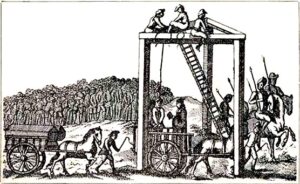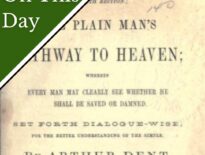
The Tyburn Tree, the gallows
On 11th January 1584, in the reign of Queen Elizabeth I, Blessed William Carter was executed for treason.
Printer William Carter, who was about thirty-six years of age at his death, had been found guilty of treason for printing a book which allegedly contained a passage inciting the queen’s assassination. He was hanged, drawn and quartered at Tyburn.
Here are some facts about this Tudor printer...
- William Carter was born in around 1548 in London, and was the son of draper John Carter and his wife, Agnes.
- On 2nd February 1563, Candlemas Day, Carter became apprenticed to John Cawood, who had been Queen's Printer to Mary I and who was joint Queen's Printer to Elizabeth I. Carter served Cawood for a term of 10 years, before becoming secretary to Nicholas Harpsfield. Catholic Harpsfield had been Archdeacon of Canterbury under Cardinal Pole in Mary I's reign, and had been a zealous promoter of the heresy trials of Protestants. He had also been imprisoned by Elizabeth I's government for refusing to swear the oath of supremacy and was still in Fleet Prison when Carter became his secretary.
- In 1575, when Carter was about 27 years of age, Harpsfield died and Carter got married. At this point, Carter also set up his own printing press on Tower Hill in London, with the aim of printing Catholic literature.
- On 23rd September 1578, Carter was imprisoned in the Poultry Compter for recusancy. He hadn't been attending Protestant services. He spent just over a month in prison. Then, in 1579 he ended up in the Gatehouse Prison for recusancy. His printing press was seized along with books he'd been working on and books he owned.
- While Carter was in prison, evidence was found connecting him to the 1578 publication and printing of Gregory Martin's "A Treatise of Schism", which encouraged Catholics to avoid going to Protestant services.
- In 1581, the government decided that the prisons must be cleared, so Carter was released under conditions. He agreed to remain within three miles of his home in Hart Street, St. Olave's, until he conformed to the religious legislation and attended Protestant services. He also had to agree not to "admit the access of any Jesuit massing priest or seminary priest, or recusant, or keep any Catholic servant or partner." He had to pay 100 marks, a large sum, as surety.
- After his release, although Carter refrained from printing books, he did trade in them. In July 1582, the famous priest-finder and torturer Richard Topcliffe and his men searched Carter’s home, allegedly finding vestments, chalices and crosses, and other objects related to Carter’s Catholic faith. They also found a copy of "Disputations in the Tower", about Edmund Campion's disputations in the Tower with his Protestant adversaries. Another book found at this time was Harpsfield's "Treatise of the Pretended Divorce", about Henry VIII's Great Matter, and Harpsfield's opposition to the annulment of the king's marriage to Catherine of Aragon.
- Carter was arrested and taken to the Tower of London, where he was imprisoned. There, he was racked in an attempt to get names of Catholic contacts out of him, but Carter would not break. He did not betray anyone.
- Carter spent 18 months in the Tower and sadly his wife died during his imprisonment.
- In January 1584, Carter was moved to Newgate Prison, and on 10th January he was tried for printing Martin's "Schism". The charge stated that the book exhorted English women to follow the example of the Bible's Judith and cut off Elizabeth I's head. Carter pleaded not guilty to inciting the assassination of his queen and defended himself well. However, he didn't stand a chance against the prosecution, who pointed out that the book was written by a traitor, approved by a traitor and addressed to traitors. The jury returned their verdict after just 15 minutes, finding him guilty, and he was sentenced to death.
- Carter was hanged, drawn and quartered on 11th January 1584. He was beatified in 1987 by Pope John Paul II, becoming Blessed William Carter.



Leave a Reply